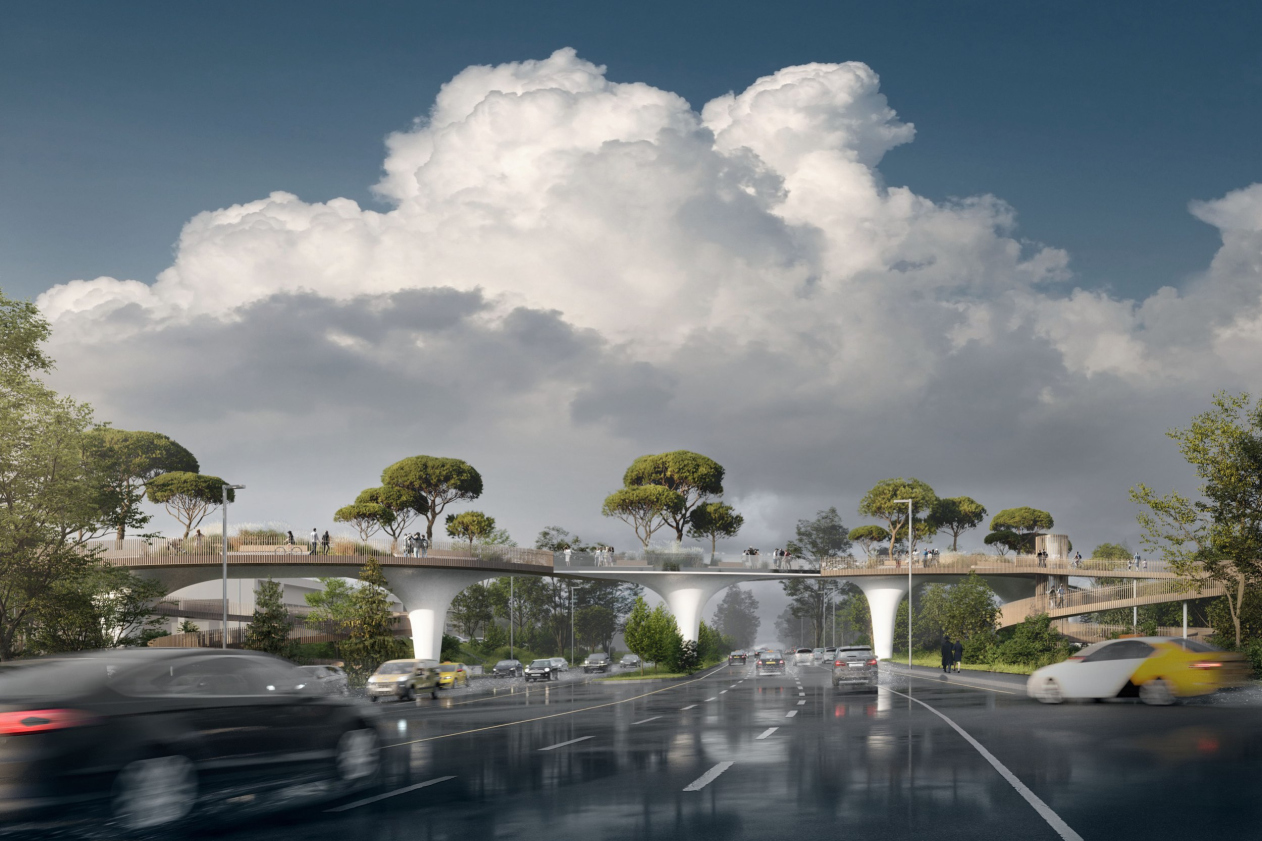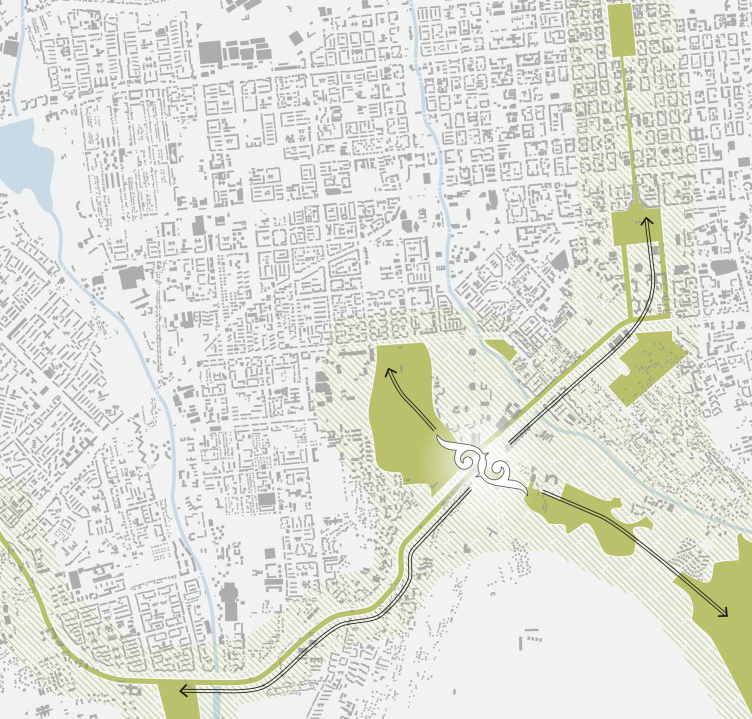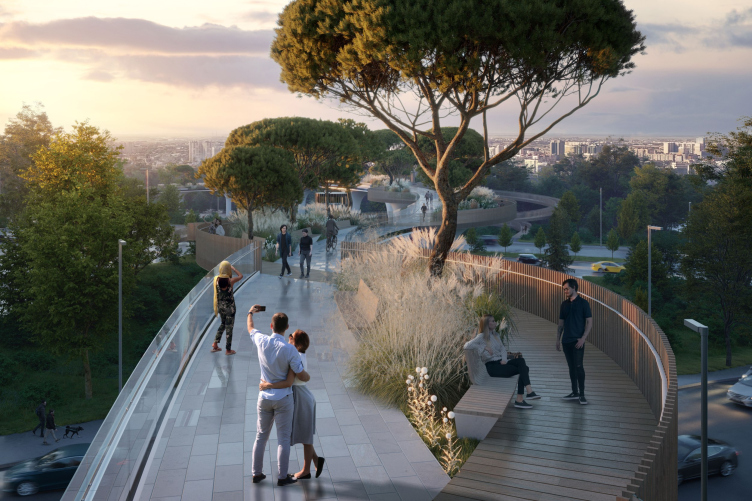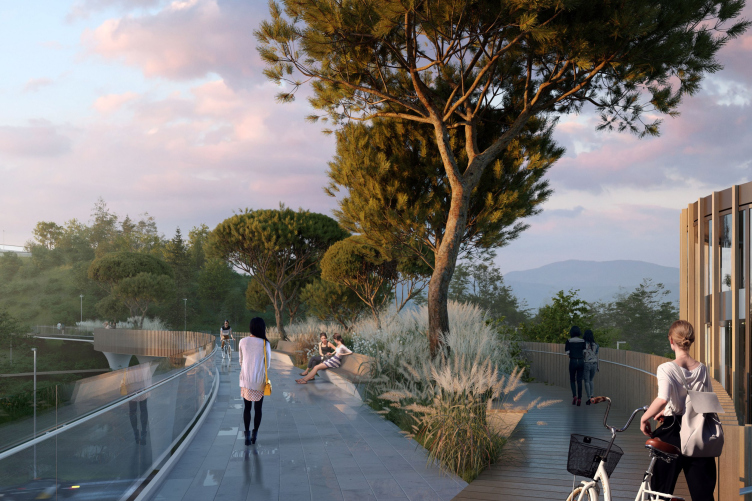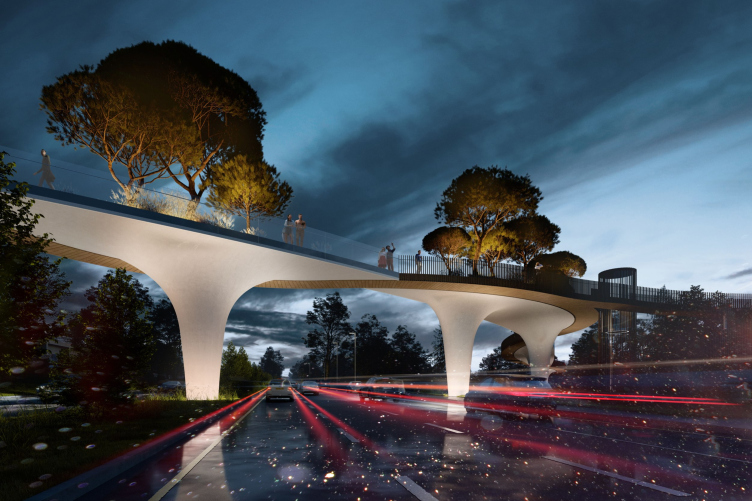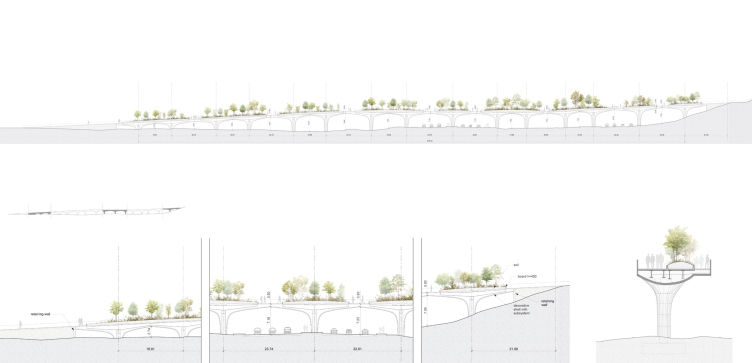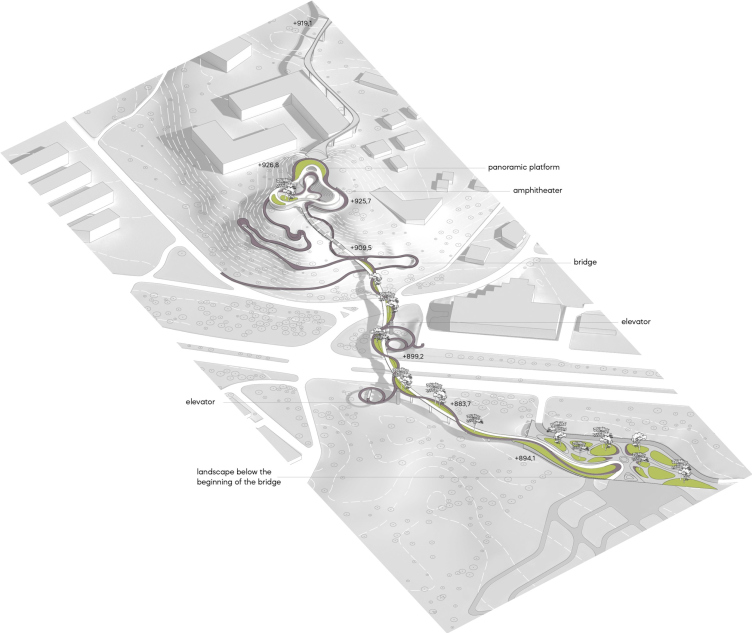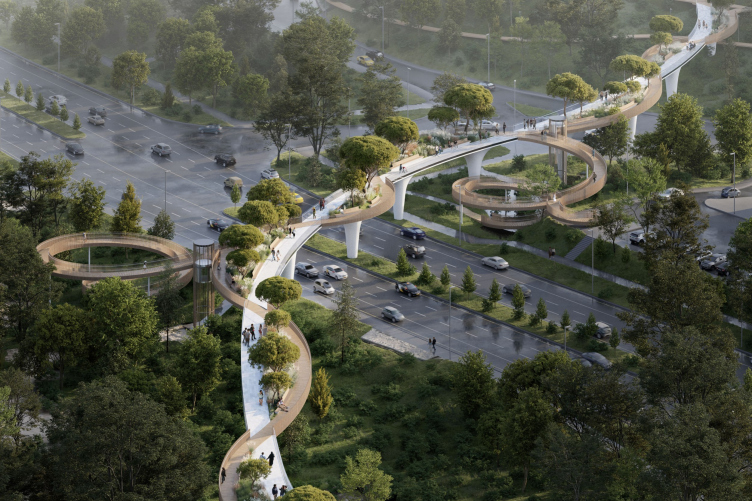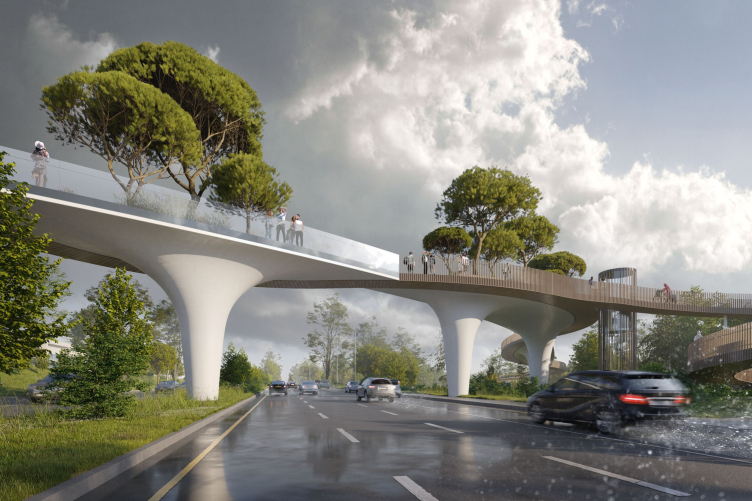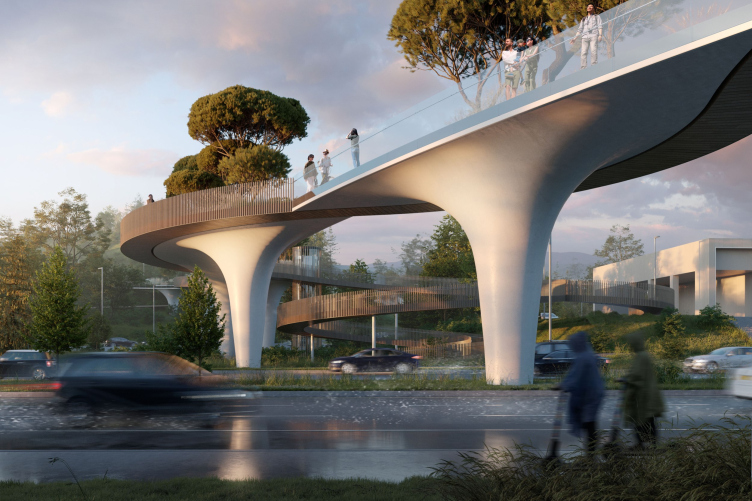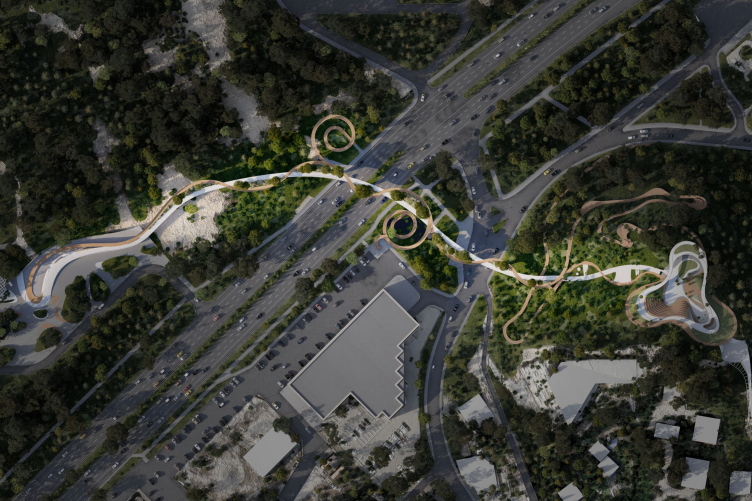The city of Almaty occupies a large territory; its southwest part is essentially foothills, and, hence, is only partially developed – mostly with clusters of country homes and getaways. One of them is called “Kurortnoe” (“Resort”), and is situated next to the Sunkar skiing area. The actual city territory is separated from these leisure and sports grounds by the Al-Farabi Avenue that is part of the ring road of the southeast part of Almaty: this is a rather busy highway with three lanes of traffic on each side. Making overland pedestrian crossings on such highways is not the best idea. On the opposite side of the avenue, inside the central part of the city, there is the Botanical Garden, one of Almaty’s biggest parks.
The location plan. The green pedestrian bridge in Almaty
Copyright: © ATRIUM
In order to connect the two recreational zones, the ATRIUM architects were commissioned in the past 2021 with a project of a flyover pedestrian bridge. Currently, it is still on paper, but the probability of it being built in the future does exist.
The typology of such bridges, as a rule, is rather well-known and habitual: these are metal-and-plastic things, rarely livened up by the fantasy of a designer, much less an architect.
The bridge designed by ATRIUM is quite a different matter, however, and more than just a technical facility built over a highway. First, it is roofless, and it has trees and grass growing upon it; second, it is large, elongated, and integrated into the landscape – essentially, these are two bridges, interwoven with one another: one is almost straight, and the other is very winding and consists of ramps with a 5-degree tilt.
Rather, it is not even a bridge but a park tourist attraction or even a mini-park. The well-known High Line Park and other famous modern artificial city parks come to mind, which allow the pedestrians to enjoy more green views than on average. In this specific case, however, one will be able to walk over a hanging park, admiring both the greenery and the stream of cars speeding by.
The green pedestrian bridge in Almaty
Copyright: © ATRIUM
The green pedestrian bridge in Almaty
Copyright: © ATRIUM
And, third, this sculpture of a bridge is simply beautiful. It is obvious enough that this project develops the ideas that can be seen in the project of the bridge running over the “Green River” park in the “Symbol” housing complex that the architects have been designing and building for years now, since 2011. It is just as obvious that this project is very much in the vein of modern trends – you cannot help but recall the Little Island Park next to Pier 55 designed by Thomas Heatherwick. The concrete “trees” that carry real trees are a very appropriate idea for a modern city: it is brave, paradoxical, and doable at the same time because the giant cachepots can contain a volume of soil sufficient for a root system of any (or almost any) tree. The drivers, cruising down the ring road, will have particularly many things to be amazed at, should the project ever come to fruition.
The green pedestrian bridge in Almaty
Copyright: © ATRIUM
The green pedestrian bridge in Almaty
Copyright: © ATRIUM
Section views. The green pedestrian bridge in Almaty
Copyright: © ATRIUM
The two main points of entrance to the bridge are also designed as mini-parks. In the Botanical Garden from the “city” side, the bridge leads to a “Fish Pond”, a flat and rather large plaza. On the opposite “mountain resort” side, in the fork between the Remizovka and Kapparova streets, there is a hill, its topmost point being 130 higher, but with a “saddle” depression in the middle. Here, in the depression, the architects place an amphitheater and a plaza with an exit in the direction of the slopes, as well as an overpass and a viewing platform on top of the hill. On the outer side of the hill, there is a winding path for those who prefer to walk on foot. This way, the architects emphasize, all the solutions are inscribed into the landscape; they are based on its features, and, hence, do not require any considerable excavation work, and are cost-effective.
Axonometric view. The green pedestrian bridge in Almaty
Copyright: © ATRIUM
The two paths – the concrete bridge itself and the wooden ramp that accompanies it throughout its entire length – are superimposed like the stem and ringlets of a floral ornament. They are complemented by verticals of the circular elevator chutes, and the differences between the two paths are deliberately accentuated: the “straight” concrete part is equipped with glass barriers, and the winding part is fully wooden; the intertwining of the two structures can be both felt and traced from different vantage points.
The green pedestrian bridge in Almaty
Copyright: © ATRIUM
The green pedestrian bridge in Almaty
Copyright: © ATRIUM
The green pedestrian bridge in Almaty
Copyright: © ATRIUM
The green pedestrian bridge in Almaty
Copyright: © ATRIUM
If you look at the winding plan of the bridge – particularly its central part hanging above the highway, where the ringlets of the ramps take a distinctly spiral shape – you can easily see the prototypes of the national decoration ornament, some sort of a meander. “The national ornaments are also used in the parametric patterns of the columns, backlit at night” – the architects specify. Meanwhile, we will emphasize that the traditional motifs are not just superimposed or used as a sign of the presence of the theme but are interpreted in a very modern way, inscribed into some flowing pattern and are functionally justified: the ringlets appear only in the spots where they are necessary for ascending. And the pattern of the columns is not just based upon national ornaments – it is parametric.
The green pedestrian bridge in Almaty
Copyright: © ATRIUM
And, last but not least – the project became the only Russian project that won (this being the judging panel’s choice) in the “Unbuilt Transportation” nomination of the A+A Awards by Architizer. This event is worthy of attention not just because that this competition involves hundreds of projects, including such world stars as David Adjaye, Thomas Heatherwick, Kengo Kuma, and others, but also because of the fact that Russian projects do not get a lot of awards this year, and many Russ – possibly, expecting a loss in advance – opt out of submitting their projects for international awards. However, it turns out that everything is possible for a really interesting project. The project is also examined in more detail by our colleagues from “Project Russia”.
The green pedestrian bridge in Almaty
Copyright: © ATRIUM

